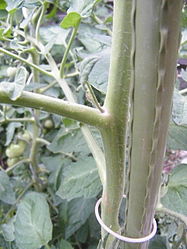Greediness
Epicormic shoot or avarice (Irxentrieb, Irxenbrut, axillary shoot, Augäste, but teeth) are mostly barren Runners from the leaf axils between the summer driving and petiole of some plants grow such. B. in grapevines , tobacco or tomatoes .
Stingy instincts are to be distinguished from water shoots .
tomatoes
In conventional cultivated tomatoes (stick tomatoes), the stinging shoots are normally carefully broken off (pinched out) as early as possible. Care must be taken that the trunk is not damaged. If tomato sting is not removed, the plant becomes bushier and richer in leaves. Precipitation then dries off more slowly and this encourages brown rot and fungal growth. In addition, an underdeveloped tomato plant becomes so heavy in weight, both as a whole and on its partial shoots, that it is difficult to support and easily breaks off.
Bushy growth is desirable for vine tomatoes, their side shoots also develop fruits and as many small fruits as possible should be produced. That is why these are usually not or hardly exhausted.
grapevine
Stingy shoots in the vine are side shoots of the green summer shoot, which emerge from an inner shoot system (also known as summer bud, although no bud is visible) in the leaf axils during the vegetation period. If these develop early in the growing season, they form an additional leaf surface, the assimilates of which are mainly shifted into the grapes of the main shoot.
construction
Stingy instincts are just like the green annual instinct and also form their organs. The later start of development means that all organs are made smaller and maturity takes place accordingly later. The wood ripeness is usually insufficient, especially when the stinginess begins to develop late. The grapes that develop on it are small and their number depends on the grape variety and the annual weather. Stinging shoots are only used for pruning in exceptional cases.
Skimming
In the earlier common stick culture, the stinging shoots were removed as early as possible. It was believed that they competed with the main drive. This is where the name greediness comes from. Experiments in the 1960s and 1970s have given us a better understanding of the function and advantages of these drives. They promote the ripening of the grapes on a shoot and are therefore not removed. Stingy shoots are only removed where they contribute to foliage compaction in the grape zone in order to reduce the promotion of fungal diseases.
Stinging grapes
In good years, around 100–400 kg of streaked grapes ( herring ) can be harvested per hectare . Harvesting is time consuming and in most cases is not done. In the very early years, the grapes can be a welcome source of acid for young wines that are too low in acid . Some winemakers use the wine that is made from stinged grapes to make a brandy.
Web links
literature
- Jancis Robinson : The Oxford Wine Lexicon, 3rd revised edition . 1st edition. Gräfe and Unzer Verlag, Munich, 2007, ISBN 978-3-8338-0691-9 .
- Karl Bauer and coworkers: Viticulture , 8th edition. Austrian Agrarverlag, 2008, ISBN 978-3-7040-2284-4
Individual evidence
- ^ Fritz Schumann, Weinbaulexikon , Meiniger Verlag, Neustadt / Wstr. 1998, ISBN 3-87524-131-2 .
- ^ Karl Bauer and colleagues: Viticulture , 8th edition. Austrian Agrarverlag, 2008, ISBN 978-3-7040-2284-4 , p. 57.







